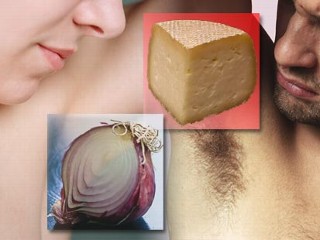Men Smell of Cheese and Women of Onions
Swiss Study Picks Out Gender Differences in Body Odor
Little girls may be made of sugar and spice and all things nice, but their armpits smell of onions. And while free of slug or snail odours, men's armpits pack a powerful cheesy whiff.
That's the conclusion of research in Switzerland that involved taking armpit sweat samples from 24 men and 25 women after they had spent time in a sauna or ridden an exercise bike for 15 minutes.
The researchers found marked differences in the sweat from men and women. "Men smell of cheese, and women of grapefruit or onion," says Christian Starkenmann of Firmenich, a company in Geneva that researches flavours and perfumes for food and cosmetics companies.
The team found that the women's armpit sweat contained relatively high levels of an odourless sulphur-containing compound -- 5 milligrams per millilitre of sweat versus 0.5 milligrams in men. When the researchers mixed this compound in the lab with bacteria commonly found in the armpit, the bugs turned it into a thiol - a previously discovered odour from armpits that is akin to onion.
"The more sulphur precursor we added, the more intense was the malodour," says Starkenmann, whose team's results appear in Chemical Senses. Bacterial enzymes turn the otherwise odourless precursor into the malodour.
The men, meanwhile, had relatively high levels of an odourless fatty acid which turned into a cheesy odour when exposed to the same types of bacteria.
Odour control strategies could be tailored based on these findings, potentially leading to gender-specific deodorants that target either sulphur compounds or fatty-acid-based precursors to prevent body odour at its sourceThe balance of oniony to cheesy precursors in women's sweat made it smell worse than men's as rated by independent smell assessors.
Next, the team hope to develop new ingredients for deodorants that fight the smells. "We could make inhibitors that neutralise the precursors, or block the bacterial enzymes that do the conversion," says Starkenmann.
Some researchers are sceptical that gender is the main deciding factor, arguing that the patterns found in Swiss volunteers might not apply to other populations with different diets and genetic backgrounds. "Other factors include what you eat, what you wash with, what you wear and what genes you inherit," says Tim Jacob of Cardiff University in the UK.
news story at abcnews.go.com
